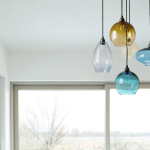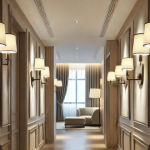Introduction
Lighting is an essential element of interior design. It can make or break the ambiance of a space. High ceilings can be challenging to light up without creating a harsh and sterile feel. This is where suspended lights come in. They not only provide the necessary lighting but can also be a focal point of interior décor. In this article, we discuss the different types of suspended lights suitable for high ceilings and how to choose the perfect one for your space.
The Types of Suspended Lights
Pendant Lights
Pendant lights are probably the most popular type of suspended lighting. They consist of a single light fixture hung from a ceiling canopy. Pendant lights come in various styles, shapes, and sizes, making them versatile enough to fit in different interior designs. Examples of pendant lights suitable for high ceilings include chandeliers, drum shades, and glass pendants.
Linear Suspension Lights
Linear suspension lights are ideal for lighting up rectangular or oblong high-ceilinged rooms. They consist of multiple light fixtures suspended from a linear canopy. Linear suspension lights can create a contemporary look and provide even lighting across a space. They come in different designs, from minimalist to elaborate.
Cluster Lights
Cluster lights are a trendy suspended lighting option suitable for high ceilings. They consist of multiple spherical or cylindrical light fixtures clustered together at various heights. Cluster lights can create a cascade effect and become a statement piece in any space.
Choosing the Perfect Suspended Light for Your High Ceiling
The Ceiling Height
The height of your ceiling will determine the type of suspended light you should choose. A high ceiling may require a more elaborate light fixture to fill the space without looking small or insignificant. A low-hanging pendant light may look out of place in a room with a tall ceiling.
The Style of Your Room
The suspended light should complement the style of your room. For instance, a delicate crystal chandelier may look out of place in a rustic or minimalist room. In contrast, a linear suspension light may not fit in a room with an ornate décor. Consider the color and materials used in your space when choosing a suspended light.
The Function of the Space
The function of the room should also influence your choice of suspended light. A formal dining room may require a more elaborate chandelier, while a home office may need a more functional and minimalist suspended light. Bedroom lighting is often more subdued, and you may need a fixture with a dimmer option.
Installation and Maintenance of Suspended Lights
Hiring a Professional
Installation of suspended lights requires skills and expertise. The installation process involves dealing with electrical wiring and fixing the light fixture into the ceiling. A professional electrician can ensure that the suspended light is well anchored and safely installed.
Maintenance
Suspended lights are often high up and can be difficult to maintain. It is advisable to clean and dust them regularly to prevent dust and cobwebs from accumulating. You can use a soft cloth or a feather duster for routine cleaning. For more extensive cleaning, you may need to remove the fixture and clean each part separately.
Conclusion
Suspended lights offer a practical and stylish solution for lighting high ceilings. With the variety of styles, shapes and sizes available, choosing the right one can be a daunting task. However, by considering factors such as ceiling height, room style, and function, you can find the perfect suspended light to complement your space. Proper installation and maintenance of your suspended light fixture will ensure that it lasts long and continues to provide an elegant and functional lighting solution.







